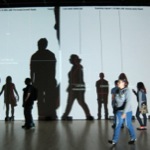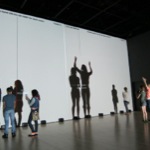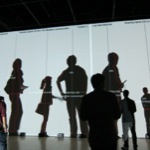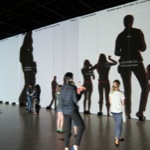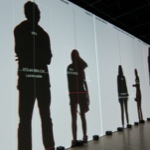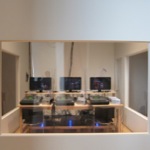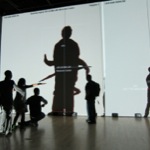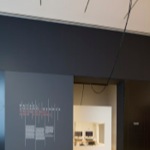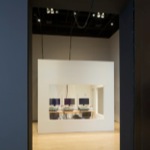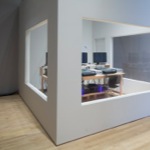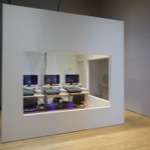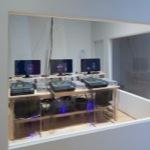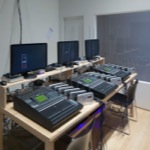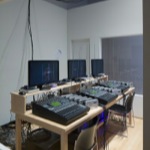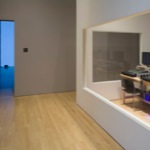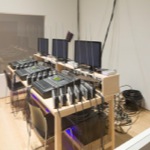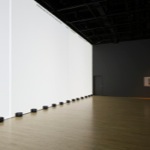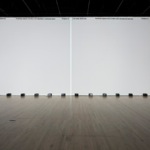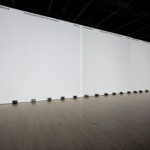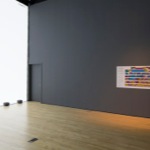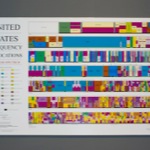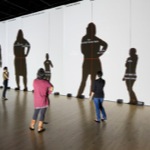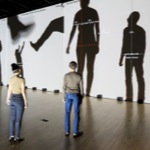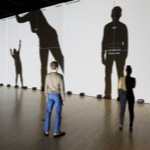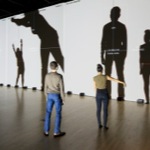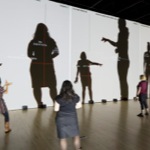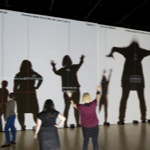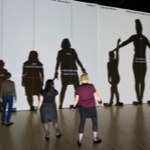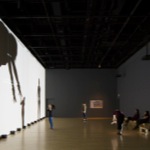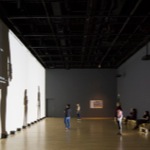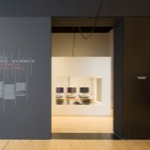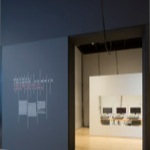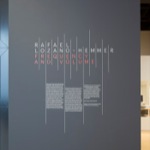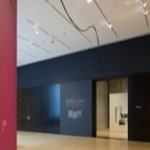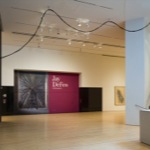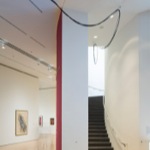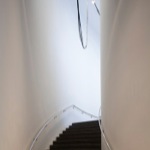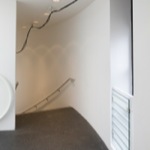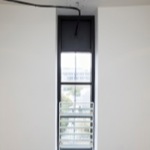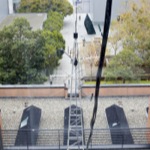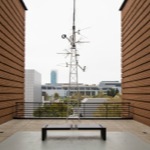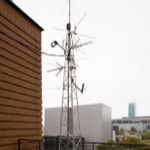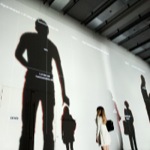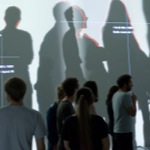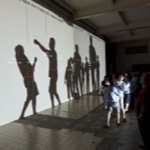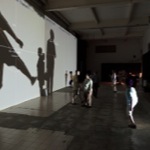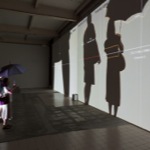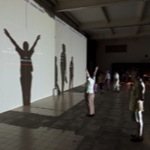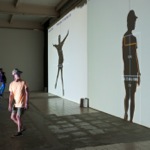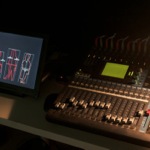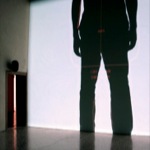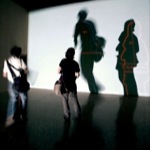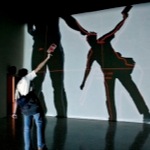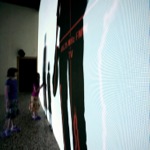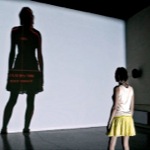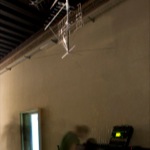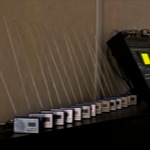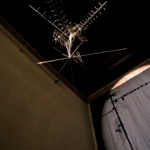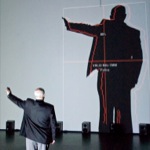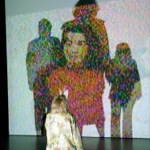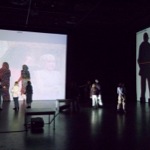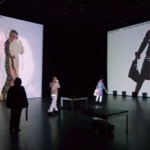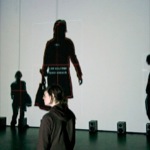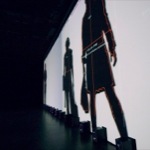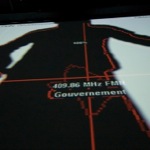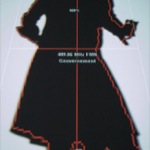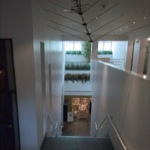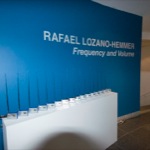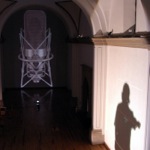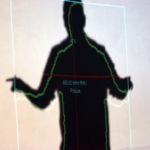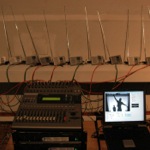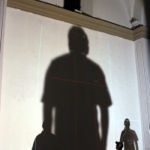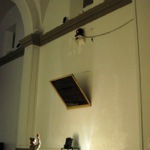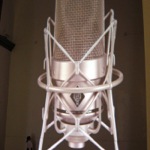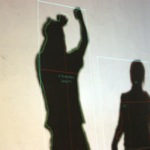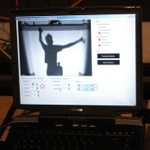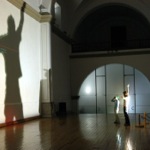Frequency and Volume
Relational Architecture 9
“Frequency and Volume” (Relational Architecture 9) enables participants to tune into and listen to different radio frequencies by using their own bodies. A computerized tracking system detects participants' shadows, which are projected on a wall of the exhibition space. The shadows scan the radio waves with their presence and position, while their size controls the volume of the signal. The piece can tune into any frequency between 150 kHz and 1.5 GHz, including air traffic control, FM, AM, short wave, cellular, CB, satellite, wireless telecommunication systems and radio navigation. Up to forty-eight frequencies can be tuned simultaneously and the resulting sound environment forms a composition controlled by people's movements. This piece visualizes the radioelectric spectrum and turns the human body into an antenna. All the receiver equipment used and antennae are exhibited in an adjacent room.
The project was developed at a time when the Mexican Government was very active in shutting down informal or "pirate" radio stations in indigenous communities in the states of Chiapas and Guerrero. The question "who has access to the public space that is the radioelectric spectrum" is one that deserves attention and visualization tools not just in Mexico but also here in the developed world, where there is a remarkable assymmetry in the assignation of frequencies only to government or corporate interests to the detriment of community-building, experimental or artistic uses of the spectrum. This project was inspired by the "Manifesto for Antenna-Man" and the radio poetry experiments by the Mexican estridentista artists in the 1920s.
The project was developed at a time when the Mexican Government was very active in shutting down informal or "pirate" radio stations in indigenous communities in the states of Chiapas and Guerrero. The question "who has access to the public space that is the radioelectric spectrum" is one that deserves attention and visualization tools not just in Mexico but also here in the developed world, where there is a remarkable assymmetry in the assignation of frequencies only to government or corporate interests to the detriment of community-building, experimental or artistic uses of the spectrum. This project was inspired by the "Manifesto for Antenna-Man" and the radio poetry experiments by the Mexican estridentista artists in the 1920s.
General info
Spanish name:
Frecuencia y Volumen
Year of creation:
2003
Technique:
Projectors, cameras, computers, radioelectric scanners, antennae, radios and 48 channel sound system
Dimensions:
Variable
Keywords:
Edition:
3 Editions, 1 AP
Collectors:
Fundació Sorigué, Singapore Art Museum and private collector
Exhibitions
- Rafael Lozano-Hemmer: A Draft of Shadows, Bildmuseet, Umeå, Sweden, 2014 - 2015.
- Frequency and Volume, San Francisco Museum of Modern Art, San Francisco, California, United States, 2012 - 2013.
- Espectros, Arts Santa Mònica, Barcelona, Spain, 2011 - 2012.
- Rafael Lozano-Hemmer: Trackers, La Gaîté Lyrique, Paris, France, 2011.
- "Open House" Singapore Biennale 2011, Singapore Art Museum, Singapore, Singapore, 2011.
- Open Space, NTT InterCommunication Center, Tokyo, Japan, 2009.
- The World is Yours, Louisiana Museum of Modern Art, Copenhagen, Denmark, 2009.
- Frequency and Volume, The Curve, Barbican Centre, London, United Kingdom, 2008 - 2009.
- Commissioned by Kate Rich.
- Some Things Happen More Often Than All Of The Time (52 Biennale), Biennale di Venezia, Mexican Pavilion, Venice, Italy, 2007.
- Art Meets Media, NTT InterCommunication Center, Tokyo, Japan, 2005.
- Elektra Festival, Musée d'art contemporain de Montréal, Montréal, Québec, Canada, 2005.
- Navigator exhibition, National Taiwan Museum of Fine Arts, Taichung, Taiwan, 2004.
- Relational Architectures, Laboratorio Arte Alameda, Mexico City, México, 2003.
Credits
- Direction: Rafael Lozano-Hemmer
- Programming: Conroy Badger
- Production Assistance: Andrew Welburn, Matthew Biederman, Natalie Bouchard, Emily Bates, David Lemieux, Stephan Schulz
- Frequency Scanning Support: Helmut Riexinger, Winradio
- Originally commissioned by: Laboratorio Arte Alameda and curator Priamo Lozada in Mexico City in 2003
Bibliography
- "El shadowista by Goyo." Tiltfactor, 29 Jan. 2017. Hanover, New Hampshire, United States, 2017. (english) (Websites)
- "10 exposiciones imprescindibles de 2015 (julio-diciembre)." Código, 29 June 2015. Mexico City, México, 2015. (Magazines)
- "Nivel de confianza, de Rafael Lozano-Hemmer." Revista Código, 9 Apr. 2015. Mexico City, México, 2015. (español) (Magazines)
- "Interaktiva installationer och kubansk samtidskonst." Allt Om Västerbotten, 8 Mar. 2015. Sweden, 2015. (svenska) (Websites)
- Baillargeon, Stéphane. "Le globe-trotter des arts." Le Devoir, 14 May 2007. Montréal, Québec, Canada. (français) (Newspapers)
- Barrios, José Luis. "Rafael Lozano-Hemmer." Código Postal 06140 Year 2 No. 16, Aug. 2003. Mexico City, México. (español) (Magazines)
 Bosco, Roberta. "Making different waves: Barcelona show explores electromagnetic radiation." El Pais, 21 Oct. 2011. Barcelona, Spain, 2011. (english) (Newspapers)
Bosco, Roberta. "Making different waves: Barcelona show explores electromagnetic radiation." El Pais, 21 Oct. 2011. Barcelona, Spain, 2011. (english) (Newspapers)- Bosco, Roberta and Caldana, Stefano. "Lozano-Hemmer crea para el MOCA su primera obra totalmente en red." El Paìs, 8 July 2004. Madrid, Spain. (español) (Newspapers)
- Brunner, Christoph and Jonas Fritsch. "Beyond the network: experiential fields and urban media ecologies." Mediacities, 2013. Buffalo, New York, United States. (english) (Books)
- Celis, Laura. "La Tecnología Encuentra al Arte." La Cultura y las Artes, Nov. 2011. Mexico City, México, 2011. (español) (Magazines)
 Clayton, Richard. "An interactive show with unsettling devices." Financial Times, 17 Sep. 2010. London, United Kingdom, 2010. (english) (Newspapers)
Clayton, Richard. "An interactive show with unsettling devices." Financial Times, 17 Sep. 2010. London, United Kingdom, 2010. (english) (Newspapers) Cohn, Terri. "San Francisco Rafael Lozano-Hemmer." Art in America, Apr. 2012, 155-156. New York City, New York, United States, 2013. (english) (Magazines)
Cohn, Terri. "San Francisco Rafael Lozano-Hemmer." Art in America, Apr. 2012, 155-156. New York City, New York, United States, 2013. (english) (Magazines)- Fernández, Maria. "Illuminating Embodiement: Rafael Lozano-Hemmer's Relational Architectures." Architectural Design vol. 77, no. 4, July/august, July 2007. London, United Kingdom. (english) (Magazines)
- Frèrot, Christine. "Rafael Lozano-Hemmer." Art Nexus, 2012. Bogotá, Colombia. (english) (Magazines)
- Graham, Beryl. "“Amplification” Singapore Biennale 2011, exhibition catalogue." Singapore Art Museum, 2011. Singapore, Singapore. (english) (Books)
- Hernández, Edgar A.. "Cae en coma, curador de la bienal veneciana." Comunidad, 6 June 2007. Mexico City, México. (español) (Newspapers)
- Herrera, Adriana. "Lozano-Hemmer: conmover al mundo." Poder y Negocios, 3 June 2008. Mexico City, México, 2015. (español) (Magazines)
- Hisako, Hara and Kubota Tetsu. "Best picks: Media art shows to watch for in Japan - Art Meets Media: adventures in perception." ART iT, 2005. Tokyo, Japan. (english and japanese) (Magazines)
- Jezik, Enrique. "Rafael Lozano-Hemmer ‒ Laboratorio Arte Alameda." ArtNexus, vol. 2, no. 50, September – November, 2003. Bogotá, Colombia. (english and español) (Magazines)
 Lack, Jessica. "Artist of the week No. 11: Rafael Lozano-Hemmer." The Guardian, 15 Oct. 2008. London, United Kingdom, 2014. (english) (Newspapers)
Lack, Jessica. "Artist of the week No. 11: Rafael Lozano-Hemmer." The Guardian, 15 Oct. 2008. London, United Kingdom, 2014. (english) (Newspapers)- Lalwani, Bharti. "Between Artists in the News and The Hotel Merlion." Art India: The Art News Magazine of India. June 2011 Volume XVI Issue I, June 2011. India. (english) (Magazines)
- Le Mauvais Coton. "[Paris] Gaîté Lyrique: l'expo TRACKERS." Le Mauvais Coton, 4 Oct. 2011. Paris, France, 2013. (français) (Websites)
- Malaw, Lityin. "L'art sonore: histoire de sons et de bruits." Digitalarti, 9 Dec. 2016. Paris, France, 2017. (français) (Websites)
- Malvido, Adriana. "Rafael Lozano-Hemmer ‒ De luz y ondas sonoras." Spot, no. 14, 2004. (español) (Magazines)
- Mayer, Mónica. "Rafael Lozano-Hemmer: ¡el Ana Guevara de las artes visuales!." El Universal, 14 June 2003. Mexico City, México. (español) (Newspapers)
- Medina, Cuauhtémoc. "Participación y persecución." Reforma, 3 Nov. 2004. Mexico City, México. (español) (Newspapers)
 Medina, Pedro. "Migrations between Memory and Spectacle." ARTECONTEXTO, Vol. 15, 2007. Madrid, Spain. (english) (Books)
Medina, Pedro. "Migrations between Memory and Spectacle." ARTECONTEXTO, Vol. 15, 2007. Madrid, Spain. (english) (Books)- Moulon, Dominique. "Art Contemporain Nouveaux Médias." Nouvelles Éditions Scala, 2011. Paris, France. (français) (Books)
- Moulon, Dominique. "L'Art de la Participation." MCD Musiques et Cultures Digitales, Sep. 2010. Paris, France. (français) (Magazines)
- Paul, Carlos. "México vuelve a la Bienal de Venecia tras una ausencia de más de 50 años." La Jornada, 6 June 2007. Mexico City, México. (español) (Newspapers)
- Tolic, Ines. "Rafael Lozano-Hemmer at the 52nd international art exhibition in Venice." d'Architettura, No. 36, Aug. 2008. Milan, Italy. (english and italiano) (Magazines)
 Walder, Paul. "Rafael Lozano-Hemmer: fragmentos de un código fuente. Rafael Lozano Hemmer: fragments of a source code." Art.es, 2012. Spain. (english and español) (Magazines)
Walder, Paul. "Rafael Lozano-Hemmer: fragmentos de un código fuente. Rafael Lozano Hemmer: fragments of a source code." Art.es, 2012. Spain. (english and español) (Magazines)- Westbrook, Lindsey. "Team media: in action, in contemplation." SFMOMA, 2016. San Francisco, California, United States, 2016. (english) (Websites)
Photo Library (click to expand)
